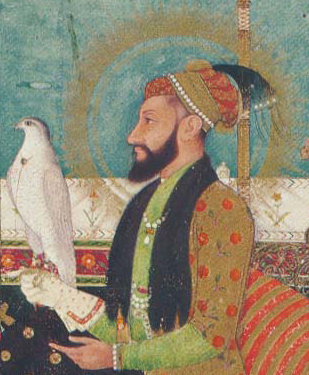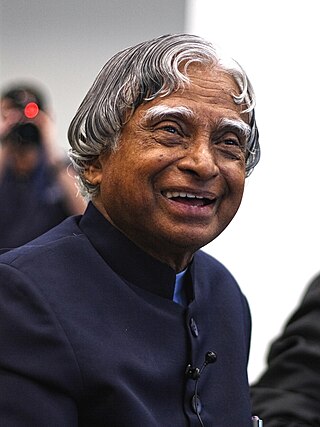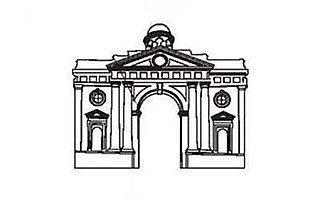
Muhi al-Din Muhammad, commonly known by the title Aurangzeb, and also by his regnal name Alamgir I, was the sixth Mughal emperor, reigning from 1658 until his death in 1707. Under his emperorship, Mughal Empire reached its greatest extent with territory spanning nearly the entirety of the Indian subcontinent.

Dara Shikoh, also transliterated as Dara Shukoh, was the eldest son and heir-apparent of the Mughal emperor Shah Jahan. Dara was designated with the title Padshahzada-i-Buzurg Martaba and was favoured as a successor by his father and his elder sister, Princess Jahanara Begum. He had been given the title of 'Shah-e-Buland Iqbal' by Shah Jahan. In the war of succession which ensued after Shah Jahan's illness in 1657, Dara was defeated by his younger brother Prince Muhiuddin. He was executed in 1659 on Aurangzeb's orders in a bitter struggle for the imperial throne.

Humayun's tomb is the tomb of Mughal emperor, Mirza Nasir al-Din Muhammad commonly known as Humayun situated in Delhi, India. The tomb was commissioned by Humayun's first wife and chief consort, Empress Bega Begum under her patronage in 1558, and designed by Mirak Mirza Ghiyas and his son, Sayyid Muhammad, Persian architects chosen by her. It was the first garden-tomb on the Indian subcontinent, and is located in Nizamuddin East, Delhi, close to the Dina-panah Citadel, also known as Purana Qila, that Humayun found in 1538. It was also the first structure to use red sandstone at such a scale. The tomb was declared a UNESCO World Heritage Site in 1993, and since then has undergone extensive restoration work, which is complete. Besides the main tomb enclosure of Humayun, several smaller monuments dot the pathway leading up to it, from the main entrance in the West, including one that even pre-dates the main tomb itself, by twenty years; it is the tomb complex of Isa Khan Niazi, an Afghan noble in Sher Shah Suri's court of the Suri dynasty, who fought against the Mughals, constructed in 1547 CE.

Kashmiri Gate or Kashmere Gate is a gate located in Old Delhi in UT of Delhi, India. it is the northern gate to the historic walled city of Old Delhi. Built by the Mughal Emperor Shah Jahan, the gate is so named because it was at the start of a road that led to Kashmir.

Goindwal, also known as Goindwal Sahib and alternatively transliterated as Goindval, is located in the Taran Taran district of the Majha region of Punjab, India about 23 km (14 mi) from Tarn Taran Sahib. In the 16th century it became an important center for the Sikh religion during the Guruship of the Guru Amar Das Ji. Goindwal is on the banks of the Beas River and is one of the focal points of small scale industries of Tarn Taran district.

The National Museum in New Delhi, also known as the National Museum of India, is one of the largest museums in India. Established in 1949, it holds a variety of articles ranging from the pre-historic era to modern works of art. It functions under the Ministry of Culture, Government of India. The museum is situated on Janpath. The blueprint of the National Museum had been prepared by the Gwyer Committee set up by the Government of India in 1946. The museum has around 200,000 works of art, mostly Indian, but some of foreign origin, covering over 5,000 years.

Khooni Darwaza, also referred to as Lal Darwaza was initially called as Kabuli Darwaza, The gate is located near Delhi Gate, on the Bahadur Shah Zafar Marg in Delhi, India. It is one of the 13 surviving gates in Delhi. It is just south of the fortified Old Delhi and was constructed by Sher Shah Suri.

Dr APJ Abdul Kalam Road is a road in New Delhi, India. It lies at the north-east end, stretching from the 'Taj Mansingh Hotel' at the roundabout of Mansingh Road, Shahjahan Road, Humayun Road, Prithviraj Road and a road to Khan Market in the north-east. At the south-west end it stretches up to the crossing at Mustafa Kemal Atatürk Marg and Safdarjung Road junction.

Salimgarh Fort was built in 1546 AD, in Delhi, in a former island of the Yamuna River, by Salim Shah Suri, son of Sher Shah Suri. There was a pause in Mughal rule when in 1540 AD Sher Shah Suri defeated the Mughal emperor Humayun and established the Sur dynasty rule in Delhi. Sur dynasty rule lasted till 1555 AD when Humayun regained his kingdom by defeating Sikander Suri, the last ruler of the dynasty. During the Mughal period, in later years, while building the Red Fort and Shahjahanbad, several Mughal rulers reigned, including Emperor Shahjahan, who is credited with completing Shahjahanabad in 1639 AD had camped at the fort. It is said that Humayun had camped at the fort for three days before launching his successful attack for recapturing Delhi.

Government Museum and Art Gallery, Chandigarh, is a public museum of North India having collections of Gandharan sculptures, sculptures from ancient and medieval India, Pahari and Rajasthani miniature paintings. It owes its existence to the partition of India. Prior to the partition, much of the collections of art objects, paintings and sculptures present here were housed in the Central Museum, Lahore, the then capital of Punjab. The museum has one of the largest collection of Gandharan artefacts in the world.

Roshanara Garden is a Mughal-era garden built by Roshanara Begum, the second daughter of the Mughal emperor Shah Jahan. It is situated in Shakti Nagar near Kamla Nagar Clock Tower and North Campus of University of Delhi. It is one of the biggest gardens in Delhi having a great variety of plants, some imported from Japan. The lake inside the garden is visited by migratory birds during winters and is a popular site for bird watching.

Bundi State, founded by Hada Rao Devda, was a princely state in India. The former state was located in modern-day Rajasthan. It was ruled by Hada Chauhan Rajputs.

Hazur Sahib, also known as Takht Sachkhand Sri Hazur Abchalnagar Sahib, is one of the five takhts in Sikhism. The gurdwara was built between 1832 and 1837 by Maharaja Ranjit Singh (1780–1839). It is located on the banks of the Godavari River at the city of Nanded in the state of Maharashtra, India.

Mirza Sulaiman Shikoh was a Mughal prince and the eldest son of Crown prince Dara Shikoh. He was executed in May 1662 at Gwalior Fort on the orders of his paternal uncle, Emperor Aurangzeb.

Mirza Sipihr Shikoh also known as Sipihr Shukoh, was a Mughal prince as the fourth son of Crown Prince Dara Shikoh and his consort Nadira Banu Begum.

Barozai is a clan of Balailzai, a Pashtun tribe in Afghanistan and Pakistan. Panni (Panri) are also known as Balailzai. The Panni are descended from Gharghasht, one of Qais Abdur Rashid sons. Originated from present Pakistan-Afghanistan border and then mostly resettled in Karachi, Quetta, Zhob, Sibi, Sangan, Musakhail, Harnai, Dera Ismail Khan, Ziarat, Mardan, Peshawar, Kabul, Tank, Kohat.

Majma-ul-Bahrain is a Sufi text on comparative religion authored by Mughal Shahzada Dara Shukoh as a short treatise in Persian, c. 1655. It was devoted to a revelation of the mystical and pluralistic affinities between Sufic and Vedantic speculation. It was one of the earliest works to explore both the diversity of religions and a unity of Islam and Hinduism and other religions. Its Hindi version is called Samudra Sangam Grantha and an Urdu translation titled Nūr-i-Ain was lithographed in 1872.

The Partition Museum is a public museum located in the town hall of Amritsar, Punjab, India. The museum aims to become the central repository of stories, materials, and documents related to the post-partition riots that followed the division of British India into two independent dominions: India and Pakistan. The museum also focuses on the history of the “anti-colonial movement, the Jallianwala Bagh massacre, the Komagata Maru incident, the All India Muslim League and the Indian National Congress, and the journey of resilience and recuperation for women”. The building wherein the museum is located in Amritsar was also “once the British headquarters and a jail”. The museum was inaugurated on 25 August 2017.

The Battle of Delhi was fought between the Dal Khalsa and the Mughal Empire in 1783.
Dara Shikoh Road is the name given to a road in Central Delhi to honour mughal prince and heir apparent of Shah Jahan, Dara Shikoh. The road was earlier named after Lord Dalhouse. This road is located just 2 km from Rashtrapathi Bhavan.





















